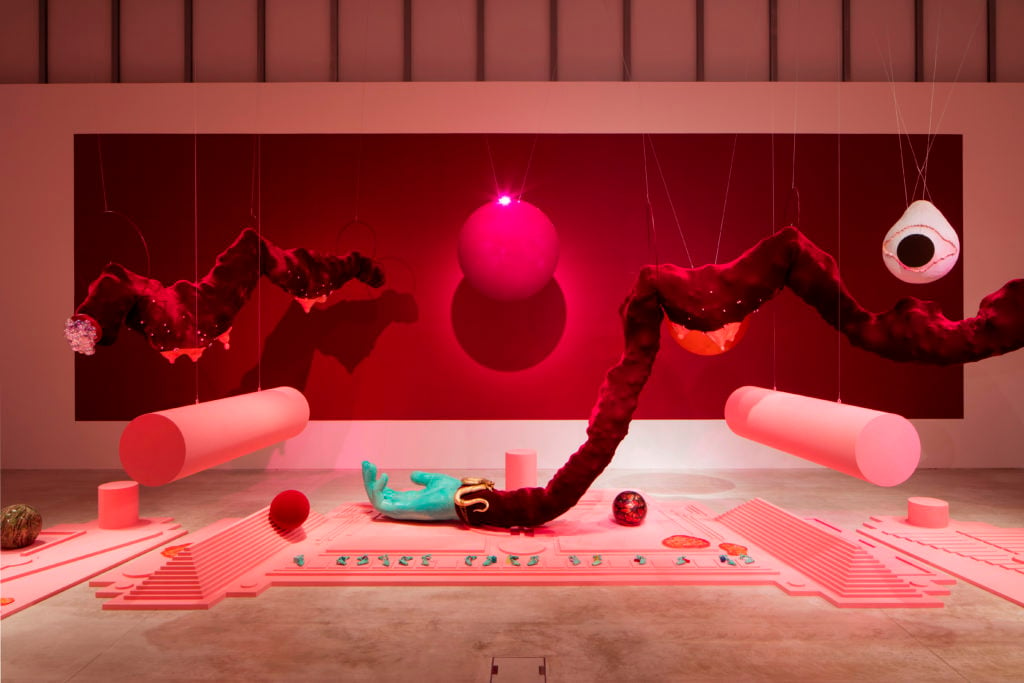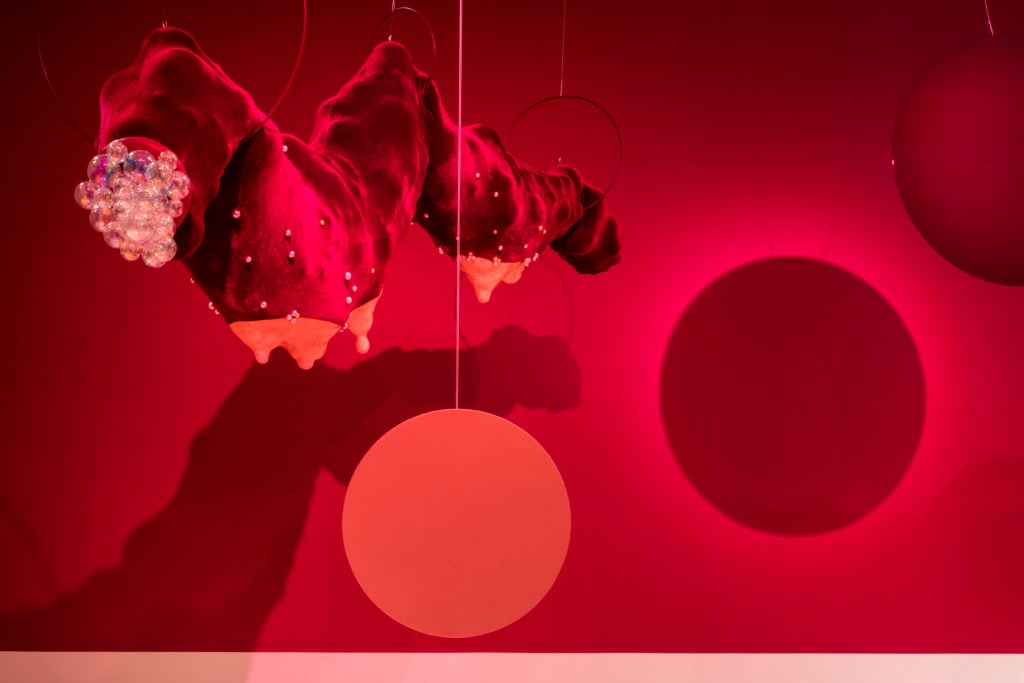Art & Exhibitions
‘Only the ‘Important’ People Get to See It, and That’s a Problem’: Turner Prize Nominee Tai Shani on the Inaccessibility of Performance Art
Shani says the costs of producing performances can be prohibitive.

Shani says the costs of producing performances can be prohibitive.

Naomi Rea

The eye-popping pink sculptural installation at this year’s Turner Prize exhibition marks a new chapter in artist Tai Shani’s “Dark Continent” series, which has occupied her practice for the past five years. On show at Turner Contemporary, the Margate gallery hosting the 2019 edition of the UK’s most prestigious art prize, is the artist’s installation evoking a mythical apatriarchal universe. A mash-up of sculpture, performance, and text, it includes an epic novel that’s narrated by an actor who appears on a screen.
“I’m incredibly honored that the politics in this work are being placed in the context of the Turner Prize,” Shani tells artnet News during a recent visit to her cramped studio in South East London. While the 43-year-old artist’s work is formally very different from the other three nominees—Helen Cammock, Oscar Murillo, and Lawrence Abu Hamdan—she says there is actually a lot of overlap between all four presentations. “We’re all looking at inequality and power in different ways, and that’s quite unique I think for a Turner Prize.”

Tai Shani, DC: Semiramis (2019). “Turner Prize 2019” at Turner Contemporary. Photo by David Levene. Courtesy the artist and Turner Contemporary.
It takes seven hours to watch the whole cycle of Shani’s work, and it isn’t easy to understand because it’s told through Shani’s florid, purple language. “When I was trying to articulate a feminist position at the beginning, I didn’t know where to start because I felt very weighed down by the monolith of white western male thought,” Shani says. Her writing draws on texts ranging from the medieval mystics (texts she likens to “the Rosetta stone of experimental literature”) to speculative and science fiction, particularly feminist sci-fi written by authors like Marge Piercy, Ursula K. Le Guin, Octavia Butler, and Donna Haraway.
A 15th-century text by Christine de Pizan, The Book of the City of Ladies, was the work’s starting point, though Shani emphasizes that her city is a 21st-century update, which does away with gender norms and the patriarchy. It is instead an inclusive space for all “womxn,” including trans and non-binary people. She sees the work as a sort of philosophical thought experiment, or a platform to think about transformative politics. “This is a created mythology,” she says. “But so is patriarchy and capitalism and history—it’s just one that huge numbers of people have collectively bought into.”
Some of Shani’s fans have bemoaned the absence of live performance in her Turner presentation. Performance has been an important part of Shani’s practice for the past 15 years, but more recently she has been focusing on installations and a more sculptural practice. She says this is partly a natural evolution, but also due to a lack of institutional support when it comes to funding performance art.
“When I found out I was nominated it became clear that I’d have to rethink what would work in that setting.” For starters, she says, the space is smaller than she is used to working with, so rather than presenting an element of her world at the same scale, she decided on a zoomed-out version of the city instead. But the bigger issue was how to fund a performance for the run of a three-month-long exhibition.

Tai Shani, DC: Semiramis (2019). “Turner Prize 2019” at Turner Contemporary. Photo by David Levene. Courtesy the artist and Turner Contemporary.
“The way that the art world is structured doesn’t support performance very well in many ways,” Shani says. “[Institutions] don’t have the resources to be able to sustain three months of everyday performance with a cast of 13.” Costs include performer fees, accommodations, travel, technical assistance, and beyond. “So I knew that I wanted to make an installation that would function and be autonomous.”
There will be a number of performances throughout the run of the exhibition, but they will be ticketed, and due to the unsettling nature of some of the text, they will also be age-restricted and viewable only after Turner Contemporary’s regular opening hours.
While there have been some strides toward encouraging collectors to invest in performance, such as a new performance art fair, it is rare for a collection to acquire performance. Shani says she was “extremely fortunate” that Arts Council England acquired the protocol for her performances, which, she explains, is kind of a manual for how to stage the work, consisting of 12 videos of the performances, the script, some of the hand-made costumes, the 3D plans for the floor, and some of the hand-made sculptures.
The financial realities of staging performance also limits where it is shown and who gets to see it. Even with the healthy budget of Glasgow International, Shani could only do performances for the first three days of the festival, accessed mainly by VIPs. The performance program at the Venice Biennale this year faced the same issue. Despite funding from Arts Council England, biennale curator Ralph Rugoff said the cost of running the performances beyond the opening week and closing weekend was prohibitive.

Tai Shani, DC: Semiramis (2019). “Turner Prize 2019” at Turner Contemporary. Photo by David Levene. Courtesy the artist and Turner Contemporary.
Similarly, Anne Imhof’s Golden Lion-winning performance in Venice, Faust, could only be shown in its full five-hour version during the opening week in 2017. It was then reduced to a two-hour performance with the full version only show on the weekend. This year’s Golden Lion winner, the Lithuanian pavilion’s climate change opera Sun, Sea, Marina, had to confront a similar problem: It cost a whopping $3 a minute to run. Even with the support of crowdfunding, after the vernissage week, it has been running just once a week on Saturdays.
“Only the ‘important’ people get to see it at the opening and such, and that’s a problem,” Shani says. “Because then ultimately what happens is that the fallout of that is on the artists and not on a kind of critique about how we finance these things. It becomes, like, ‘Oh I went to see it and it was empty and it was shit’ as opposed to a recognition that this artist couldn’t be supported.”
Shani hopes the art world shifts from making massive investments in single works of art toward sustaining the livelihood of performers.“You’re not just putting financial investment into objects,” she says, “you’re investing in the livelihood of the artists that perform in the work too.”